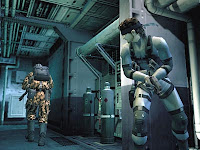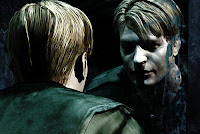.

Moby Dick. The Mona Lisa. Citizen Kane. Super Mario World.
It’s not hard to look at this list and pick the odd man out. Books, paintings and movies have long pedigrees and critical acceptance. They are mediums of artistic expression, and they yield art.
It’s unlikely that anyone will seriously compare the artistic merit of Mario to Macbeth. However, as the video game industry grows and changes, more developers release games that aspire to some level of artistic significance. Look at a game like Rez, a shooting game which is more about its luminous, pulsating visual world than its shooting mechanics. Or witness Bioshock, an action game in which the player is placed in a decaying undersea metropolis meant to represent the doomed application of philosopher Ayn Rand’s objectivist theory. Games like these definitely push the limits of what video gaming can be, but do they push them into the realm of art?
That’s a question few have been shy about answering, and pundits the internet over debate it with fierce conviction. A number of heavy-hitters have even joined the fray. In 2006, film critic Roger Ebert famously opined that video games were not and could never be art. Mr. Ebert was just as famously rebuked by British horror novelist and film director Clive Barker, who countered that games were art and that Mr. Ebert and his ilk had outdated notions of what art can and cannot be. The dust from that fight has settled, but the arguments continue.
Questions like these immediately lead to others. Just what is art? How should it be categorized? Who can and cannot make it? These questions are not new, and a debate over whether Miyamoto stacks up to Melville is unlikely to answer them. We can safely assume we’re in for a long haul, but until the day we wake up to find the matter settled, we’re happy to be along for the ride.
Views from the Top
Venerable film critics aren’t the only people making the case against video games as art. That opinion also sounds from an unlikely source: video game developers themselves. David Rodriguez, lead designer at development studio High Voltage, says that he realized he was not an artist once he recognized his place in the economic hierarchy of the biz. “…an artist gets to do what they want, how they want, when they want. That's not what I do. Someone comes to my company with a contract. They give us money to make something. I make it. They take it and sell it. I don't work in art. I work...in customer service.”
It’s an argument that has been made before. Video games, unlike books or even movies, are almost required to have significant commercial elements to them. A personal vision, so the argument goes, is very important to a piece of art. It’s difficult if not impossible to express a personal vision through a video game because every major release has to be backed by a giant studio more concerned with money than with artistic merit. Also consider that whatever personal vision may exist at the outset of a game’s creation can be lost as it is filtered through the minds of the designers, programmers, and other professionals essential to the making of a video game.
This argument is well-worn, but it has its limits. For example, couldn’t it apply just as well to Hollywood movies? Movies, at least most of those coming to a theater near you, need a large amount of financial backing to be successful. They also employ a great many people, from writers to actors to editors to sound engineers, through which the director must funnel his personal vision. And yet the movie industry has cranked out big budget films that are nonetheless heralded as high art. Is Schindler’s List looked down upon because it cost a bundle to make? Is Apocalypse Now any less a piece of art because it employed half of Hollywood during its production? The answer to both of these questions is no.
On an economic level, then, big-budget video games and big-budget movies are not very different. So why do video games continue to be labeled as mere toys while this year’s Oscar contenders get classified as art? Perhaps the question is one of intent.
Solid Snake: Philosopher KingAs commonly understood, a piece of art is intended to illicit an emotion or explore a theme. Hate, love, death, life: these are themes works of art have tried to explore since before cavemen drew on rock walls. Even the most mindless summer blockbuster is out to make the audience think or feel, even if it’s only trying to make them feel like buying lunchboxes. Few would argue, for example, that Transformers 2 is great art, but it is intended to excite and move an audience, and because of that intent it is considered a work of art.

Not all video games can claim such intent. Many games are more concerned with simulating an experience than with exploring the meaning of that experience. For example, each yearly edition of the Madden series aims to simulate control over a football team, but makes precious few contributions beyond that. Numerous arcade games create large rigs to best simulate driving, skiing, snowboarding and more. Some of the most popular video games of recent years have been of an avowedly casual nature. Nintendo has been at the forefront of this revolution, releasing games like Wii Fit and Brain Training, which are intended to help maintain the player’s bodily and mental health respectively. None of the above games are intended to make the player think or feel to any significant extent, and in that they are missing a crucial component of what makes art artistic. If Wii Fit can be called an artwork, so can an aerobics class at your local gym.
However, there do exist video games intent on exploring the same themes as the best works of art. Every new Final Fantasy game has a twisting narrative intended to stir the player’s emotions. Series like Zelda and Grand Theft Auto have became successes because they built complete worlds from the ground up and urged players to joyfully explore their every corner. Games like these would seem to have intentions more in line with accepted works of art, but are those intentions enough to make them so?
As an example, take one the most conceptually ambitious video game series of the last several years: Metal Gear Solid. The premise is simple: players take control of Solid Snake, a grizzled operative of an elite paramilitary group, as he plumbs the depths of international espionage. However, ever since the first game in the series debuted in 1998, creator Hideo Kojima has made clear that he intended to use the series to explore the big questions. War, death, love, life. All were expounded upon, often at great length, by the many characters populating the series’ byzantine narrative. These characters moved through a world constructed with love and attention to detail. The series often set benchmarks for graphical excellence, and it took players on a journey through frozen military bases, lush jungles, mist-shrouded cityscapes and more, all the while mulling on the philosophical and political questions of the day. If any video game could be called a work of art, it would surely be this one.

Strange that its creator thinks otherwise. When asked about Mr. Ebert’s view on video games as an art forms, Hideo Kojima sided with the film critic. “I don’t think they’re art either, videogames… a videogame is interactive, so it's something used by people… in that sense, it’s totally not art.” In the interview, Kojima opines that video games incorporate art, and that this art is created by the creators of the video game, but that video games are not themselves works of art.
That video games incorporate art is undisputed. A professional texture artist wields his mouse as skillfully as any painter his brush. The Metal Gear Solid series is packed to the gills with exquisitely crafted cinematic sequences spliced with the latest in Hollywood action filmmaking. The music in several of the games is composed by Harry Gregson-Williams, a composer whose credits include Hollywood films like The Rock and Shrek. How then can all of these elements combine to be something less than the sum of their parts? How can pieces of art, skillfully arranged, add up to anything less than art?
Mr. Kojima perhaps sums it up best. "Art is the stuff you find in the museum, whether it be a painting or a statue. What I'm doing, what videogame creators are doing, is running the museum--how do we light up things, where do we place things, how do we sell tickets? It's basically running the museum for those who come to the museum to look at the art.” Good art girds the foundations of any good videogame, but as Mr. Kojima points out, the most important participant in a video game is not the artist. The most important participant is the player.
The textures of a video game are art, and can be displayed on their own in Kojima’s museum. The same goes for the cinematic sequences and the music. However, the act of playing the video game, of choosing which textures to look at and deciding which cinemas to watch and which to skip, is up to the player. The principle of choice is inherent in video games and is what separates them from paintings or sculptures or books or movies. The player can walk through the museum. He can observe and even interact with the art on display, but his choices are his own. The artists behind the video game have worked hard to show things to the player, to express something to him, but the player’s choices are not subject to the artist’s authorial intent. The essence of art is that it express something about and through its author or authors, but in a video game the player is their own author, essentially giving birth to their own story as they play through the game.
Video games incorporate art. Video game designers employ great artistry in arranging those pieces of art, but because the essence of the video game relies on the ability of the player to make their own choices, video games as they exist today cannot be considered art. This does not mean that video games are not worthwhile. This does not mean that video games cannot move a person to tears or make them laugh or teach them important skills, but it does mean that they are not art.
Or at least, not yet. The technology behind video games is growing by leaps and bounds. Developers are becoming ever more ambitious in their rush to do something new. Is it possible that in the future some developer will solve the problem of authorial intent and finally make a video game that can be called a true work of art?
Welcome to Silent HillVideo games aspire to be works of art. The essence of a video game is choice, yet choice is antithetical to the authorial nature of art. It’s a problem. If video game developers want to make works of art, their challenge is to construct the player’s choices such that those choices are still expressive of the author’s intent. It’s a conceptually tricky proposition, but many developers have tried to create games in which the player’s choices are central to the point the game is trying to make. Common example include games like Knights of the Old Republic and Fable, role-playing games wherein the actions a player takes determine whether the player’s in-game avatar is represented as good or evil.
These experiments with player choice are interesting but largely unsubtle. More often than not, the player is merely given the choice between becoming either a pious saint or a bloodthirsty murderer. If developers want to create games which can stand beside great works of art, they must explore the more subtle gradients of human experience. The industry being where it is, not many such games have emerged. However, there a few which point the way, chief among them Silent Hill 2.

Released by Konami in 2001, Silent Hill 2 tells the story of James Sunderland, a taciturn widower summoned to the game’s titular town by a mysterious letter from his late wife Mary. The game itself plays like many other horror games of its day. As James, the player wanders around the town solving puzzles, battling monsters, and fighting the game’s cumbersome controls in an attempt to find the source of the letter. Compared to most story-based video games, Silent Hill 2 is thematically rich. James is an unstable and unreliable avatar, and at different points the game looks at themes such as death, murder, and suicide with surprising subtlety. However, what differentiates Silent Hill 2 from games with similar ambitions is the way in which it folds the player’s choices into the outcome of the narrative.
James wants to find the source of the letter. James wants to find his wife. The player sympathizes and makes that mission his own, but over the course of the game James’ motivations become increasingly unclear. At one point in the narrative, the reason for James’ crusade is taken away from him. The player, having sympathized with James and his objective, is thus faced with a question almost no video game ever dares ask: why keep playing? Unbeknownst to the player, the game has been asking this question the entire way through, testing the player’s dedication to the mission through a series of camouflaged choices. How fervently has the player searched for Mary? Has he read her letter? Has he looked at her picture? Through these and other choices, the game decides where the player’s loyalties really lie, and it doles out its justice accordingly. It has guided the player’s choices so carefully that the player didn’t even know he was making them, and it is through this that the player reveals himself to the game.
More than any other video game of its generation, Silent Hill 2 takes what is unique to video games, the necessity of choice, and uses it to express something. The game’s graphical design drips with menace. Its narrative is precisely constructed to unhinge, but the whole is incomplete without the player’s choices. It is those choices, so quietly presented and made, which allow the game to hold up a mirror to the player. It doesn’t always work, but when it does it represents exactly the kind of subtle shading the video game industry must strive for if it wants to create something closer to a work of art.
The video game industry is not small. Not all developers will attempt the delicate touches and pinpoint ambition all but required to elevate their games closer to art, nor should they. The industry is more than big enough to accommodate the shoot-em-ups, the simulators, the storybooks and everything else in between. But those developers who try for something different should be commended, and their efforts should be watched for signs of the future. I agree with Roger Ebert that video games as they exist now are not art, but I’m not sure that they never can be. The wheels are already in motion, and it’s best for everybody that they continue to spin.





